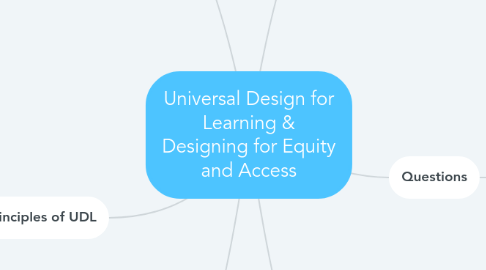
1. Challenges
1.1. Institutional
1.1.1. Technology
1.1.2. Support services - Writing centers, accessibility offices, etc
1.1.3. Investment in/emphasis on teacher training
1.2. Teachers
1.2.1. Managing workload
1.2.1.1. Monitoring implementation of UDL when designing + leading class
1.2.1.2. Extra time/work of adapting to student/class needs
1.2.1.3. Finding time for effective assessment + feedback
1.3. Learners
1.3.1. Managing workload
1.3.1.1. Balancing required/optional assignments and activities
1.3.1.2. Not overwhelming students with too many assessments while still tracking progress
2. Questions
2.1. How do different institution types (2 year vs. 4 year) engage with UDL/equity issues?
2.2. What are students' personal experiences with accessibility/equity in the classroom?
2.3. How should ULD meet the needs of different student populations?
2.3.1. Blind students
2.3.2. Students with invisible disabilities
2.3.3. Remote students
2.4. How does an institution maintain continuity in equity/access across courses/instructors?
2.5. What has been the impact of technological innovations on equity/access?
2.6. What has been the Impact of this week's readings on planned learning engagements?
3. Defining UDL + Methods
3.1. Student-focused
3.1.1. Tap into all student's strengths
3.1.2. Respond to student needs - Tailor
3.2. Reflection
3.2.1. Students
3.2.2. Instructors
3.3. Purposeful
3.4. Transparent
3.5. Provide support/scaffolding - meet students where they are
3.6. WHERETO
4. Principles of UDL
4.1. Principle One: Multiple means of Representation
4.1.1. Alternative representations of lectures
4.1.2. Videotape lectures
4.1.3. Powerpoints accompanying every lecture
4.1.4. Student note-takers
4.1.5. Multiple forms of discussion groups
4.1.6. Multiple choices for textbook/readings
4.1.7. Ensuring assigned texts are available in accessible formats - digital and audio versions
4.2. Principle Two: Multiple Means of Action and Expression
4.2.1. Provide opportunities for students to submit assignments in alternate formats
4.2.2. Offer multiple ways to earn participation credit
4.2.3. Provide different options for in-class assessment to provide feedback every class session - index cards, minute papers, etc
4.3. Principle Three: Multiple Means of Engagement
4.3.1. Provide choices for students in how to engage with information + other students
